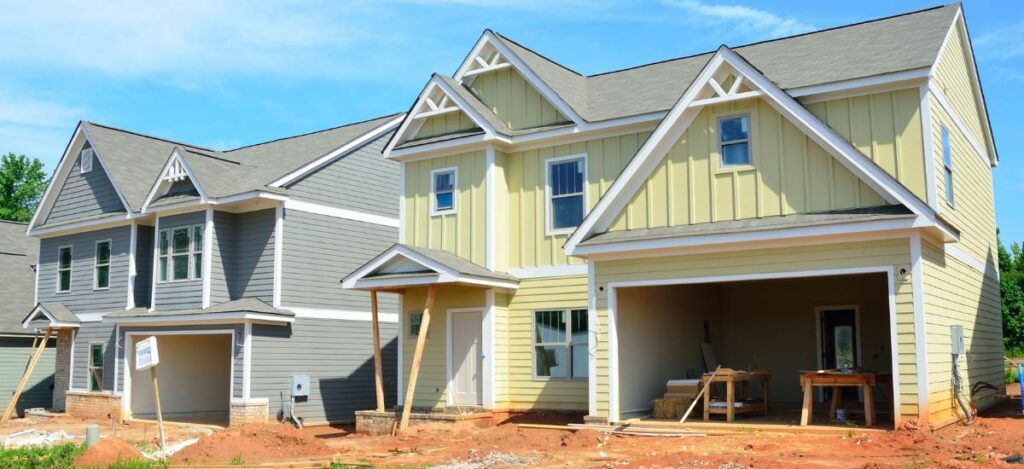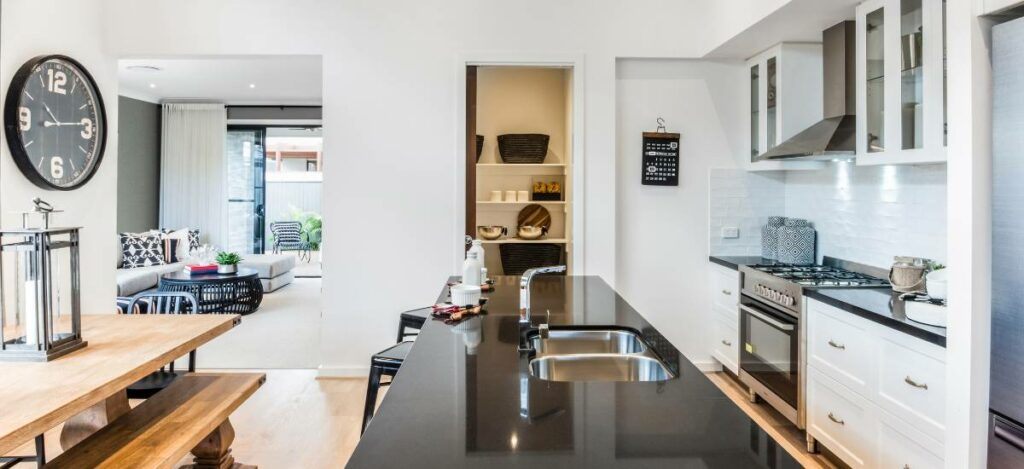Types Of Construction Loans
Up to 100% Financing
For residential builders
Interest Rate
10.5 - 11.5%
Origination fee
from 1.5 - 2%
Loan To Cost (LTC)
up to 90%
Construction Financing
up to 100%
Loan To ARV
up to 75%
Term
18 months
Minimum Loan Amount
$100,000
Maximum Loan Amount
$5,000,000
Minimum FICO
650
Type of Property
Residential 1-4 units, condos, townhomes
The 3 Main Types Of Construction Loans
There are various types of construction loans that can be used by real estate investors for different purposes. Flexibility and tailored financial solutions are vital parts of creating a successful construction project. Three of the most useful types of construction loans are construction to permanent loans, construction-only loans and renovation loans.
1. Construction to Permanent Loan

A construction to permanent loan (C2P loan) is essentially a two-in-one financing option. The construction phase of the project is covered by the construction to permanent loan, which then transitions into a traditional mortgage.
During the construction phase of the project, borrowers can get access to funding for the building of the property, and they only need to pay the interest on the loan. During the construction phase, borrowers will receive funds in stages or draws to pay for building costs. These draws are typically based on completed milestones, to provide the necessary funds at each stage of construction.
Once this phase is complete, construction to permanent loans will then transition into traditional mortgage or permanent loans which will have longer terms of 15 to 30 years. From there, borrowers will need to make payments that cover both the interest and the principal loan amount.
The main benefit of construction to permanent loans is that borrowers only need to pay one set of closing costs, which results in lower overall fees on the loan. A construction to permanent loan also a good way to lock in mortgage financing for the project once construction comes to an end.
2. Construction-Only Loan

As the name suggests, a construction-only loan is used solely for the purpose of financing the construction phase of a real estate project. These loans typically have shorter terms that range from 6 months to a couple of years, along with adjustable rates. Construction-only loans are best suited to real estate investors who are going to sell the property once the construction is complete.
During the construction phase borrowers only need to pay the interest on the loan, which is an advantage as it creates more freedom in the borrower’s cash flow. Once the construction phase is complete, the loan will need to be paid back in entirety, or refinanced into a mortgage.
Investors who plan on selling the property once the renovations are complete would usually use this type of construction loan. It allows for flexibility with investors who have a shorter-term outlook on the project and gives investors what they need during the construction phase.
3. Renovation Loans

Renovation loans typically cover the cost of purchasing a home and renovating it. The loan amount is therefore based on the anticipated value of a property after the renovations have been done. Renovation loans offer flexibility in financing both minor and major renovations, such as structural repairs, room additions, or cosmetic upgrades.
This loan type is suited to those who are upgrading an existing home, rather than building a new one. The options which fall under renovation loans include a cash-out refinance and Home Equity Line of Credit (HELOC). Typically, a lender will not require the borrower to disclose exactly how the funds are going to be used in this scenario, so the homeowner or investors would manage the budget, plans and payments themselves.
The main benefit of renovation loans is that they offer a large amount of flexibility and autonomy to borrowers, who can use the funds as they need.
Residential Construction Loans vs Commercial Construction Loans
While residential and commercial construction loans are similar because they both provide financing for construction projects, the nature of the projects and the loans are a little different.
Residential construction loans are primarily used for properties for personal use, like building single-family homes, condominiums, townhouses, or small multi-unit properties like duplexes or triplexes. Whereas commercial construction loans are designed for larger, non-residential properties like office buildings, retail centers, warehouses, hotels, and industrial facilities.
Residential construction loans are subject to consumer lending regulations and protections, while commercial construction loans are subject to fewer consumer protections but may have more stringent regulations and laws.
Residential construction loans have shorter loan terms that range from 6 months to a few years, while commercial construction loans have longer terms that can extend to several years.
Residential construction loans are considered less risky than commercial construction loans, and as such the interest rates on these loans are lower than their commercial counterparts. For residential construction loans, the borrower’s creditworthiness, income and ability to repay the loan are the focus for construction loan lenders, whereas with commercial construction loans, the strength of the project is key.
One Time Close Construction Loans vs Two Time Close Construction Loans
One Time Close construction loans, also known as single close loans, have a single closing process. The construction loan and permanent financing can be given to the borrower at once. Once the construction loan is completed, it becomes a permanent loan. The benefits of this are that the borrower only has one set of closing costs, there’s less paperwork and they’re only dealing with one loan. Borrowers are required to make interest-only payments for the construction phase and the rates are usually locked in at the beginning of the loan.
Two Time Close construction loans, as the name suggests, require two separate loan closing processes for the construction loan and the traditional mortgage. The construction loan will need to be paid back in full once the construction is complete, and a new loan will need to be initiated for permanent financing thereafter. These loans also offer interest-only payments during the construction phase however borrowers cannot lock in the interest rate for the permanent mortgage upfront, and this can fluctuate depending on the market.
What Is An End Loan?
An “end loan” is a loan used during the final stage of a real estate transaction, and it is used to pay off a short-term construction loan or other short-term financing option. Once investors have found the financing to launch their construction project, they can use an end loan to begin paying back their loan.
During the construction phase, borrowers are usually only paying back the interest on loans. However, once the project is completed, the principal loan amount will need to be repaid. This is when borrowers can find an end loan to replace the construction loan, and the end loan can serve as permanent financing for the property to pay off the loan in full.
End loans can have fixed or adjustable interest rates and terms range from 15 to 30 years. Once the end loan has been secured the borrower can have the property transferred fully into their name if they plan to hold on to the property, alternatively the end loan would facilitate the sale of the property.
How To Apply For A Construction Loan
Applying to get a construction loan can be a detailed process but here are some steps to help borrowers with the process.
Step 1: Find A Licensed Builder
A key step in the process of applying to get a construction loan, is to find a licensed and reliable builder. Construction loan lenders will want assurance that your selected builder can successfully complete the home construction. It’s a good idea to evaluate various builders to discover the blend of cost and proficiency that aligns with your requirements.
Step 2: Prepare Your Documents
The documents you will need to prepare should include a clearly defined construction plan that details the type of property you plan to build or renovate, project scope, budget, and timeline. You’ll also need to prepare any other documents that your chosen lender requires, such as financial documents which indicate that you can repay the loan.
Step 3: Get Pre-approval
Once you’ve gotten all your documents together, you should get pre-approval for your construction loan from your chosen construction loan lenders. This will allow you to find out how much you can borrow for the project and will play an important part in working out your budget and creating a plan and blueprint for the building.
Step 4: Close The loan
Closing the construction loan involves paying the closing costs, agreeing on the terms and conditions, and signing the agreement and any other documents. Bear in mind that if you get a construction loan that is not a One Time Close loan, you’ll need to secure more permanent financing for the property, before the construction is complete.
Additional Resources

This Construction Loan Calculator quickly works out the maximum loan amount that you can qualify for when applying for a Construction Loan.
Find out the latest Construction Loan Rates here. This guide explores what rate you are likely to qualify for.
First and foremost, you need to know the location of the development and you also need to have building plans and permits.
The typical down payment on a construction loan is between 10% and 20% of the total project cost.
Some lenders are better than others. This guide reveals the Best Construction Lenders at this moment in time.
This guide explains out how you can get started in the Construction Industry.
On average construction workers make over $50,000 annualy.This resource explores how much construction pays, on average.
This is a step-by-step guide which explains how to start a Construction Business.
There are various US banks providing different Construction Loan options for real estate investors
There are a number of differences between a Construction Loan and Mortgage. Each difference is fully explored in this guide.